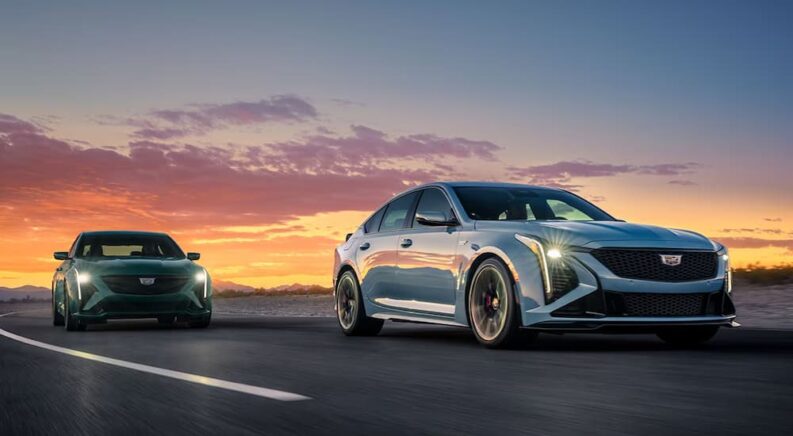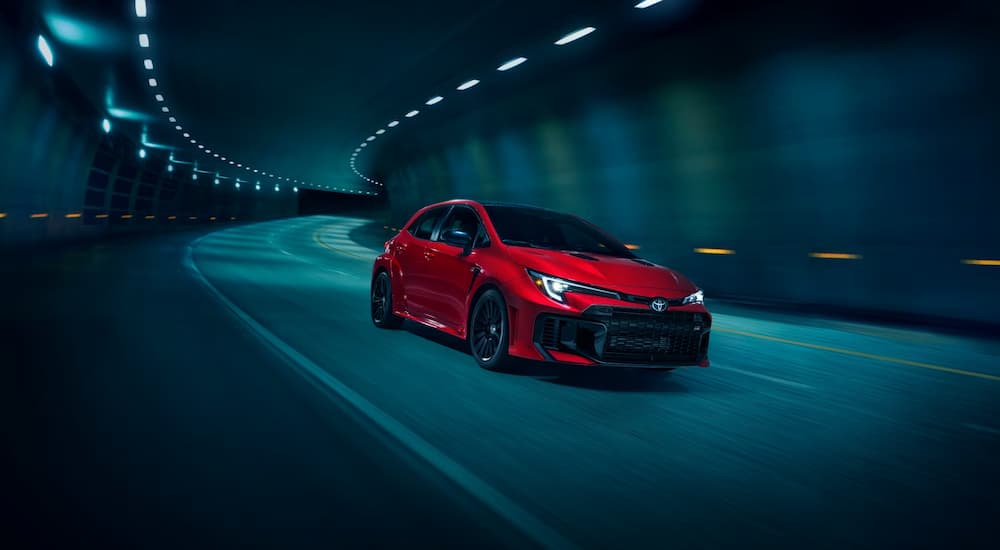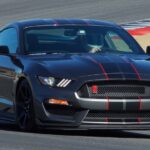Let’s say you want to experience the more thrilling side of the automotive lifestyle. You could buy a stock sedan or coupe, spend hours sifting through online research, and get to know the cashier at your local auto parts store on a first-name basis, or you could explore the wide world of high-performance sub-brands. From BMW’s M and Mercedes-Benz’ AMG to Nissan’s NISMO, Toyota’s GR, and Fiat’s Abrath, most large-volume automakers offer performance-focused sub-brands that consistently churn out ready-made racing machines. Characterized by enhanced engines, sport-tuned suspensions, flashy style, and high-end features, performance sub-brand vehicles are vital to a manufacturer’s design, development, and marketing strategy. While they might resemble the models they’re based on, they bring something very different to the table in terms of handling, performance, and ultimately, fun.
A performance sub-brand is different from the luxury offshoots some automakers embrace in an effort to cater to the higher end of the market. Many Lexus, Acura, and Lincoln vehicles do tend to offer a bit of a boost in terms of performance when compared to their Toyota, Honda, and Ford counterparts, but these models are primarily focused on luxury features like premium materials, cutting-edge comfort and convenience tech, and other components that help to elevate the everyday driving experience.
Then there are the upmarket performance automakers that lack a performance sub-brand for one simple reason. There’s little room for improvement when talking about a Porsche, Lamborghini, or Ferrari. These legendary European names embrace a high-performance ethos right out of the gate, which would make any such subsidiary a little redundant.
Where did the performance sub-brand trend start? Who are some of the major players, and why should you consider investing in some of these lesser-known brands? Read on as we explore everything there is to love about this niche segment.

M, M Good
High-performance sub-brands can largely trace their origins back to automakers’ racing divisions. These performance racing teams serve as a great marketing opportunity, giving brands a chance to showcase their latest engineering innovations and providing an enticing look at the future while allowing them to pick up a few trophies along the way. BMW is credited with kicking off the trend when it debuted the BMW M (Motorsport) racing division in 1971. M announced its presence with the BMW’s 3.0 CSL, a souped-up version of the standard E9 coupe designed to compete in the European Touring Car Championship.
The “L” in 3.0 CSL stood for “light,” with the M Division employing a thinner aluminum hood, doors, and trunk, removing unnecessary trim and soundproofing, and replacing the glass windows with a plastic Perspex alternative. The 3.0 CSL was also treated to a modest engine upgrade, allowing it to produce some 203 hp and compete in the over 3.0L category. Other enhancements included an aero package with a large air dam, short fins, a rear spoiler, and a tall rear wing that saw the 3.0 CSL dubbed “the Batmobile” in the European racing circuit. The upgrades worked a treat, with the CSL earning six Drivers titles between 1973 and 1979 and winning three rounds at the 1976 World Championship for Makes.
BMW’s M followed up on this early success and hasn’t looked in the rearview mirror since. The 3.0 CSL turned plenty of heads as it sped through some of Europe’s most iconic tracks, and drivers were eager to get their own turn behind the wheel. This demand led BMW to introduce its first M-branded car, the M1, at the Paris Motor Show in 1978. The 1986 M3 was the first M model to really capture the attention of the driving public. It’s easy to see why once you get a look at the car’s widebody fenders and 200-hp S14 engine, which was unheard of horsepower for an I-4 at the time. The M division has since produced high-performance versions of nearly the entire BMW lineup with the exception of the Z1 roadster. While BMW might have been a trailblazer in the segment, such success is always bound to breed imitation.
European Rivals Emerge
Mercedes-Benz was the next European brand to embrace the high-performance approach. AMG began in 1967 as an independent Mercedes-Benz tuning company, souping up production models for racing. Over the years, Mercedes-Benz worked more and more closely with AMG until taking a majority stake in 1999, and then full ownership in 2005.
The first official collaboration came in the form of the 1993 C 36 AMG, an understated car that still managed to hit 62 MPH in 6.5 seconds and served as the official Formula 1 Safety Car. Fusing Mercedes-Benz’s considerable luxury credentials with the sort of mad automotive experiments and expertise that only AMG could offer, models like the E 55 AMG, SLK 55 AMG Black Series, and C 63 AMG Coupe made AMG a name to watch in the performance segment.
Land Rover might represent the more rugged end of the luxury market, but that doesn’t mean that performance is treated as an afterthought at their Solihull headquarters. Just take the 2025 Land Rover Range Rover SV, which sees the full-size SUV graced with a 626-hp twin-turbocharged 4.4L V8 and a host of other performance-related upgrades, courtesy of Jaguar/Land Rover’s Special Vehicle Operations (SVO) division. Volvo’s Polestar subsidiary brings an all-electric edge to the performance market with models like the Polestar 2, 3, and 4. Audi’s RS brand and Mini’s John Cooper Works (JCW) models put a thrilling spin on some well-established models.
Premium brands aren’t the only ones injecting their vehicles with a little high-performance edge. The Volkswagen Golf R is a mainstay in the hot hatch segment with its 328 hp and standard 4Motion all-wheel drive system. Even budget brands like Fiat and Alfa Romeo have gotten in on the fun with their Abarth and Quadrifoglio performance brands. We’re not casting aspersions on models like the popular Fiat 500e, but the Abrath version represents a sizeable step up with its five-speed manual transmission, lowered suspension, and a 160-hp turbocharged I-4 engine that allows it to speed up to 60 mph nearly a full second faster than the 500e.
Back In America
Never one to be left out of the action, America’s own homegrown brands have plenty of high-speed fun available with their own performance sub-brands. If there’s one major difference between North American brands and their overseas counterparts in terms of performance sub-brands, it would probably come down to how conservatively the badge is applied. While BMW offers a wide range of M-branded vehicles, American brands tend to reserve the tag for a specific model. Chevy serves as a good example, with the ZL1 and ZR2 brands reserved for the Camaro and Corvette, respectively. It’s largely the same story at Chrysler, where the Chrysler 300, Dodge Challenger, and Jeep Grand Cherokee were the only vehicles to earn the vaunted SRT badge. Ford’s RS offerings have largely been retired since the departure of the Focus RS in 2019.
Cadillac is the exception to the rule of American performance sub-brands fading away. On the contrary, the storied luxury brand combines power and grace with its V-Series offerings, which span almost the entire sedan lineup from the CT4-V, CT5-V, and CT6-V to their ultra-high-performance counterparts in the CT4-V and CT5-V Blackwings. The regular CT5-V is certainly no slouch with a twin-turbo V6 that churns out 360 hp, but the Blackwing soars higher with 668 hp and a 200-plus-mph top speed, making it the fastest Cadillac ever built.
Leading the East
Some of the brands that dominate the Southeast Asian market take a similar approach to U.S. automakers when it comes to the high-performance segment, limiting their more enthralling options to a select few models. Despite their limited availability, these vehicles hold plenty of appeal for those looking to elevate their daily driving experience. The 2025 Civic is currently the only Honda to be given the Type R treatment, while Acura takes a similar approach with the lone Integra Type S. Subaru has long warmed rally fans’ hearts with the WRX, but the car’s STI (Subaru Tecnica International) model was discontinued in 2022 and has since been replaced by the WRX tS (“tuned by STI”) version. Lexus’ F brand currently includes a generous array of models like the IS F, LFA, RC F, and GS F. The GS F is a particular standout, delivering a 5.0L V8 engine with 467 hp, eye-catching design, and bolstered seats that’ll make you feel like you’re behind the wheel of a bona fide race car.
Nissan also provides an impressive array of performance models under its NISMO brand, with six models available. Sadly, most are reserved for those lucky drivers in the Japanese domestic market. Hyundai’s N offerings are also pretty well-rounded, with the brand marketing high-performance versions of some of their most exciting vehicles, including the all-electric IONIQ 5 N. Winner of Car and Driver’s 2024 EV of the Year award, the IONIQ 5 N will put a smile on your face with an N Grin Boost feature that temporarily allows the vehicle to produce up to 641 hp. The best part is that the N model can be had for as little as $68,000, which makes it a real value in a performance segment where prices aren’t shy about creeping towards six digits.
We’ll wrap up with Toyota’s GR (Gazoo Racing) division, which might be the most well-known sub-brand on our list. With a strong track record that includes the GR Corolla, GR Yaris, GR86 (which is almost identical to the Subaru BRZ), and the famed GR Supra, the Toyota GR brand enjoys strong name recognition and more than a few screen credits in big-budget Hollywood blockbusters. As the sportiest Toyota you can buy, the GR Supra allows every driver to unleash their inner Brian O’Conner with a turbocharged I-6 that can speed the sports car from zero to 60 mph in 3.9 seconds.
High-performance sub-brands open the door to a full array of automotive antics, whether you’re the type of driver who likes to suit up for your local track days or simply seek a more dynamic way to power through your morning commute. These models provide an engaging experience for a modest upcharge and, unlike some of the out-and-out supercars on the market, still include all the comfort and convenience features that have such an impact on the daily driving experience. BMW might have started a high-performance revolution with the original 3.0 CSL, but the segment has since grown to include some intriguing offerings from many of the world’s foremost brands, like Mercedes-Benz and Cadillac, to some surprising entries courtesy of Hyundai, Fiat, Nissan, and the like. If you’re looking for a new way to get around and have a little extra cash to spend, these performance sub-brands are worth a closer look.





